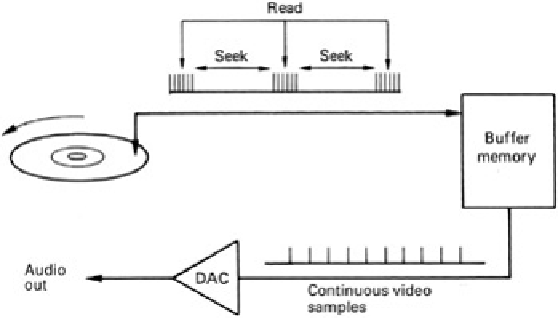Information Technology Reference
In-Depth Information
Although machines vary in detail, the flowchart of
Figure 7.18
shows the logic flow of a simple player, from start
being pressed to pictures and sound emerging. At the beginning, the emphasis is on bringing the various servos
into operation. Towards the end, the disk subcode is read in order to locate the beginning of the
first section
of the
program material.
When track following, the tracking-error feedback loop is closed, but for track crossing, in order to locate a piece of
music, the loop is opened, and a microprocessor signal forces the laser head to move. The tracking error becomes
an approximate sinusoid as tracks are crossed. The cycles of tracking error can be counted as feedback to
determine when the correct number of tracks have been crossed. The 'mirror' signal obtained when the readout
spot is half a track away from target is used to brake pickup motion and re-enable the track following feedback.
7.6 Personal video recorders
The development of the consumer VCR was a small step to end the linearity of commercial television. Increasing
numbers of viewers use VCRs not just as time shifters but also as a means of fast-forwarding through the
commercial breaks. The non-linear storage of video was until recently restricted by economics to professional
applications. However, with the falling cost of hard disk drives and the availability of MPEG compression, non-linear
video storage is now a consumer product.
The personal video recorder (PVR) is based on the random access storage of a hard disk drive. As disk drives can
move their heads from track to track across the disk surface, they can access data anywhere very quickly. Unlike
tape, which can only record or play back but not both at the same time, a PVR can do both simultaneously at
arbitrary points on a time line.
Figure 7.19
shows that the disk drive can transfer data much faster than the required bit rate, and so it transfers
data in bursts which are smoothed out by RAM buffers. It is straightforward to interleave read and write functions so
that it gives the impression of reading and writing simultaneously. The read and write processes can take place
from anywhere on the disk.
Figure 7.19:
In a hard disk recorder, a large-capacity memory is used as a buffer or timebase corrector between
the convertors and the disk. The memory allows the convertors to run constantly despite the interruptions in disk
transfer caused by the head moving between tracks.

